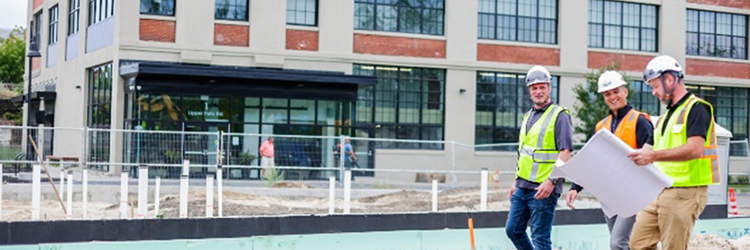The cowork house comes home - by Thomas House

It is ironic that almost as soon as the WeWork IPO failed, along comes a pandemic creating a brand new work from home market segment - though most homes lack adequately appointed space to carry on in a professional environment.
But architects and developers - along with green roofs, fitness rooms, and common-area entertaining areas - are now adding co-working space as an amenity in their residential multifamily and mixed-use projects.
These spaces dispense with the expendable (free beer and espresso machines) and instead include adjacent child-centered features, both for play as well as zoom school.
As the economy migrates to a hybrid model for professional workers, a coworking space shared with fellow professionals - not a folding table in the corner of the family living room - might not seem like an amenity at all, but a necessity.
For facilities that already host a ‘business center,’ a retrofit will likely not pose significant difficulties.
A pandemic/endemic-aware population will, of course, be attentive to important considerations such as spacing and partitions between stations, ventilation, and line of sight to any area that their children might simultaneously occupy.
What a work from home facility provides to tenants and owners is a professional space, free of home distractions and residential space constraints.
For large or high-end projects, the financial considerations are not a major consideration - it’s an idea whose time has come. Projects with a low number of residential units might have to accommodate any potential extra cost by charging a fee for access, and opening the space for external clients as well, in order to open an extra revenue stream.
Viability of the external access model will make location important, with adequate parking or easy access to transportation.
Extra fees or rentals would be lower than the conventional commercial coworking operation, but for the smaller multifamily or mixed use project, the revenue stream will cover the cost of high-speed internet, flexible workspace, conference areas, and the like.
If restricted to use only by residents with its captive clientele, commercial growth with its constant pressure to keep up with competition, is not an issue to contend with.
Whether restricted to residents or open to community access, management, scheduling, and access are readily managed with coworking software such as Yardi Kube (yardikube.com)
A Hybrid Engine
The forecast is that the outbreak essentially becomes endemic, like the flu, not scything down our fellow citizens the way it was only a few months ago. Ergo, the plan would be to keep the scale below that created by the pandemic surge. (We want that market to be smaller!)
But it is also important to note, coworking fitouts were a ‘thing’ before the pandemic: Research conducted by Gallup in 2016 showed that 43% of employees were already working remotely in some capacity, often at Starbucks. This is double the number from ten years prior, per a three year old article on Realtor.com.
This provides a baseline to scale your coworking design concept.
Tech-centric New England with its surfeit of software engineers and creative professionals is ground well-prepared for residential coworking spaces, and this would make multifamily projects in gateway cities particularly attractive to buyers and tenants.
What makes a coworking space work
One thing lost with the pandemic is the over-reliance on large communal tables. These will not be missed. Though a conference area will be a component of any work space, remote workers need workstations that afford some privacy; they should be individually sized, well spaced, and movable. At least one niche that can provide the appropriate environment of Zoom conferences or making YouTube videos.
Movable partitions can also create aerosol barriers, so these are a prerequisite. All surfaces should be washable.
Daylighting - and in a pandemic aware clientele - windows that open would be a valuable enhancement. But your knowledge of lighting a work area for productivity will not be wasted here. Do it right and you only do it once.
Fast gigabit broadband with synchronous upload speeds will do more than anything to draw a tenant into the coworking space, aware from a decrepit 70mbps down and 6mbps up (not a misprint) home account. The WiFi will need to match this capacity.
A multiplicity of outlets, readily available power strips, and charging stations should be evenly and generously distributed. And if possible, open and visible ventilation connected to outside air is both reassuring and easier to maintain.
If your coworking space is going to be open to an external clientele…. well, that’s going to be another article.
Thomas House, AIA, is the principal of THA Architects, LLC, Stratham, N.H.
Reveler Development celebrates final phase of work at The Levee - new 51-unit apartment building in Biddeford


Maine multifamily outlook: Opportunities in Portland, Bangor, and Lewiston-Auburn - Blake Wright and Kristie Russell
The multifamily market in Maine’s major cities presents a diverse range of opportunities for investors. We looked at the potential benefits and unique characteristics of three major submarkets in the state: Portland, Bangor, and Lewiston-Auburn. The information below is based on research done in CoStar and county registries, and focuses on multifamily properties that have four or more units.

Residential is here to untie the office space doom loop - by Thomas House

Interest rates and inflation - by Matthew Bacon
As we all know, interest rates have been changing drastically, with movement in both directions, depending on the type and term of financing. The Federal Open Market Committee has taken drastic action in efforts to curb abnormally high inflation, but it hasn’t controlled labor cost growth to the extent that was intended.


 (1) (1).png)





.png)


.png)